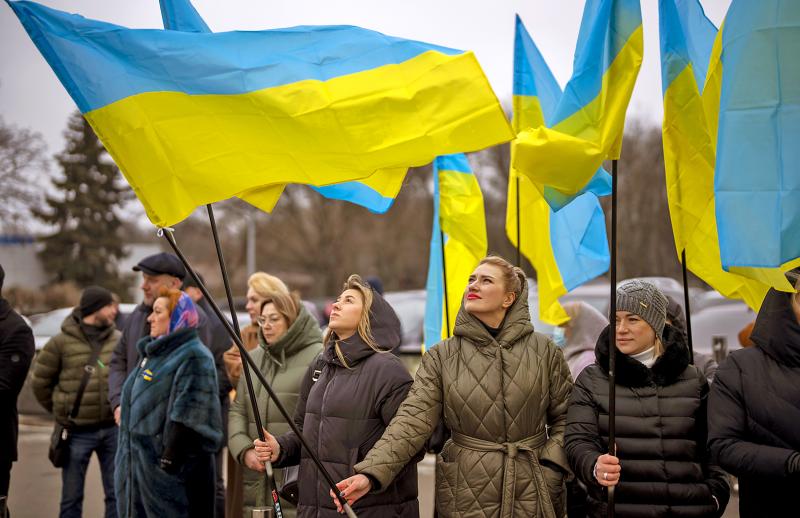China might take advantage of the Ukraine crisis and do something “provocative” in Asia while Western powers are focused on defusing tensions with Russia, a US general said yesterday, although Ukrainians were upbeat yesterday as Russian troops moved away from the border.
Russia’s deployment of more than 100,000 troops had triggered fears in Washington and other Western capitals of a looming invasion.
US Air Force General Kenneth Wilsbach, the head of US Pacific Air Forces, said that China has aligned itself with Russia in the crisis, raising questions about its own intentions in Asia.

Photo: AP
“From the standpoint of will China see what’s happening in Europe and ... try to do something here in the Indo-Pacific — absolutely yes, that’s a concern,” Wilsbach told reporters on the sidelines of the Singapore Airshow. “I do have my concerns that they would want to take advantage.”
“It won’t be surprising if they tried something that may be provocative and see how the international community reacts,” he said.
Based in Hawaii, Wilsbach’s command would likely play a central role were conflict to erupt in the Pacific.
However, later yesterday, reports from Ukraine and Belarus seemed to diminish the threat of a looming conflict.
In Kiev, Ukrainians raised national flags and played the country’s anthem to show unity against fears of an invasion.
The yellow and blue banners fluttered outside schools, hospitals and many shops to mark “Unity Day,” a holiday that Ukrainian President Volodymyr Zelenskiy created this week after Russia massed troops near their shared border.
On Kiev’s main Khreshchatyk Boulevard, where flags decorated government offices, it was business as usual for many.
“Just a normal day, but these flags are here for a purpose, to show we fear no one. They did not scare us,” said Mykola, who operates a small coffee stand in the capital.
Mykhailo Podolyak, an adviser to Zelenskiy’s chief of staff, said this week that the president had chosen yesterday as the patriotic holiday partly ironically, in response to media reports that an invasion could happen then.
In Minsk, Belarusian Minister of Foreign Affairs Vladimir Makei said that “not a single” Russian soldier would remain in the country after massive joint maneuvers near the border with Ukraine.
“Not a single [Russian] soldier or a single unit of military equipment will stay on the territory of Belarus after the drills with Russia,” Makei told a news conference.
The Belarusian Ministry of Defence and Belarusian President Alexander Lukashenko had made this clear, he said.
Russia this week announced an end to some military drills near Ukraine’s borders, including those in Belarus.
“Neither Moscow, nor Minsk, nor Kiev” wants war, Makei said.
In Moscow, the Russian Ministry of Defense released a video showing a trainload of armored vehicles moving across a bridge away from Crimea, which it annexed from Ukraine in 2014.
The Russian ministry said that the movement was part of a return of forces to their permanent bases.
While Washington and its allies continued to express skepticism about Russia’s intentions, the moves nonetheless changed the tenor, although Putin did not commit to a full withdrawal, saying that Russia’s next moves in the standoff with Ukraine would depend on how the situation evolves.
Additional reporting by Reuters and AP

SECURITY: As China is ‘reshaping’ Hong Kong’s population, Taiwan must raise the eligibility threshold for applications from Hong Kongers, Chiu Chui-cheng said When Hong Kong and Macau citizens apply for residency in Taiwan, it would be under a new category that includes a “national security observation period,” Mainland Affairs Council (MAC) Minister Chiu Chui-cheng (邱垂正) said yesterday. President William Lai (賴清德) on March 13 announced 17 strategies to counter China’s aggression toward Taiwan, including incorporating national security considerations into the review process for residency applications from Hong Kong and Macau citizens. The situation in Hong Kong is constantly changing, Chiu said to media yesterday on the sidelines of the Taipei Technology Run hosted by the Taipei Neihu Technology Park Development Association. With

CARROT AND STICK: While unrelenting in its military threats, China attracted nearly 40,000 Taiwanese to over 400 business events last year Nearly 40,000 Taiwanese last year joined industry events in China, such as conferences and trade fairs, supported by the Chinese government, a study showed yesterday, as Beijing ramps up a charm offensive toward Taipei alongside military pressure. China has long taken a carrot-and-stick approach to Taiwan, threatening it with the prospect of military action while reaching out to those it believes are amenable to Beijing’s point of view. Taiwanese security officials are wary of what they see as Beijing’s influence campaigns to sway public opinion after Taipei and Beijing gradually resumed travel links halted by the COVID-19 pandemic, but the scale of

A US Marine Corps regiment equipped with Naval Strike Missiles (NSM) is set to participate in the upcoming Balikatan 25 exercise in the Luzon Strait, marking the system’s first-ever deployment in the Philippines. US and Philippine officials have separately confirmed that the Navy Marine Expeditionary Ship Interdiction System (NMESIS) — the mobile launch platform for the Naval Strike Missile — would take part in the joint exercise. The missiles are being deployed to “a strategic first island chain chokepoint” in the waters between Taiwan proper and the Philippines, US-based Naval News reported. “The Luzon Strait and Bashi Channel represent a critical access

Pope Francis is be laid to rest on Saturday after lying in state for three days in St Peter’s Basilica, where the faithful are expected to flock to pay their respects to history’s first Latin American pontiff. The cardinals met yesterday in the Vatican’s synod hall to chart the next steps before a conclave begins to choose Francis’ successor, as condolences poured in from around the world. According to current norms, the conclave must begin between May 5 and 10. The cardinals set the funeral for Saturday at 10am in St Peter’s Square, to be celebrated by the dean of the College